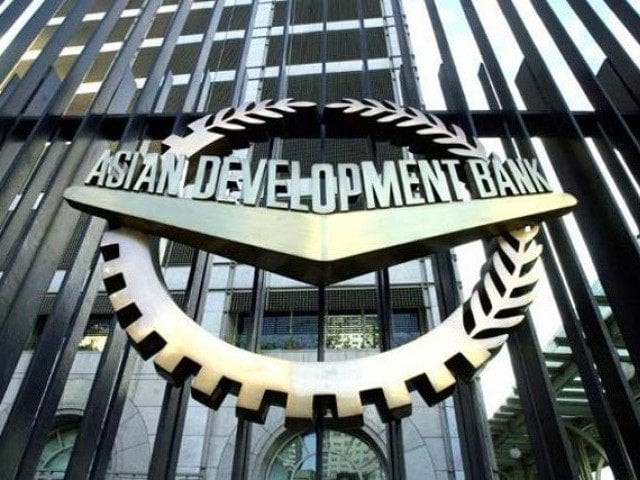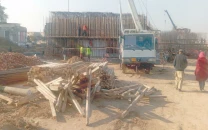Pakistan's economy to grow 2.6% this year: ADB
Cites low demand, stagnation in cotton output as reasons behind low growth

PHOTO: AFP
The Manila-based lending agency has called on Pakistan to strengthen social protection in the wake of spread of coronavirus, underlining that social-sector development has not kept pace with growing needs.
Higher spending on social protection, including the Ehsaas programme, will be crucial in responding to the Covid-19 and the serious implications it may have for poor and vulnerable segments of the population.
The Asian Development Outlook - a biannual flagship publication - shaved only 0.2% off Pakistan's economic growth on account of adverse impact of the coronavirus. About four months ago, the ADB had predicted Pakistan's economy would grow by 2.8%.
At a growth rate of 2.6%, Pakistan will be the sixth slowest growing economy in South Asia, trailed by Sri Lanka and the Maldives only.
The ongoing Covid-19 outbreak would pose a downside risk to growth prospects as it further dampened consumer demand and as private businesses were temporarily shut down in efforts to control the pandemic, noted the report.
The lender said weaker demand under Covid-19 could adversely affect exports, but on balance exports should strengthen thanks to policy stability, improvement in ease of doing business and lagged effects of currency depreciation.
"Economic growth in Pakistan is expected to slow down to 2.6% this year due to ongoing stabilisation efforts, slower growth in agriculture and the impact of the Covid-19 outbreak, before recovering to 3.2% in 2021," said the ADB.
Leaving aside external upheaval, growth in Pakistan would slow down as agriculture stagnated, notably affecting cotton output and as stabilisation efforts constrained domestic demand, it added. The intended correction of macroeconomic imbalances in Pakistan should restore confidence in the economy and bring later benefits, the bank said.
Agriculture is expected to see slow growth following the worst locust infestation in over two decades damaged harvests of cotton, wheat and other major crops. Modest growth is expected in some export-oriented industries such as textile and leather. However, large-scale manufacturing, which provides over half of industrial production, will likely contract due to currency depreciation that increased production costs for some industries and forced them to raise their prices.
Growth is expected to accelerate to 3.2% in fiscal year 2020-21, driven by a rebound in investment as macroeconomic imbalances are corrected, currency depreciation is contained and the locust infestation subsides.
Investment may also receive a boost from the implementation of critical structural reforms to improve energy production and distribution, and the overall business climate.
The ADB has placed significant emphasis on strengthening Pakistan's weaker social protection to offset the impact of the pandemic.
Spending on social development had not kept up with the growing need and the Human Development Report 2019 ranked Pakistan at 152 among 189 economies, said the ADB.
Health outcomes remain poor, featuring one of the highest maternal mortality rates in the region and the third highest child stunting rate in the world. An estimated 23 million children are out of school. It said limited employment opportunities and high out-of-pocket health care expenditure routinely locked people in poverty and all too often inflicted economic shocks that dragged them down into it.
Over 63% of the population is under the age of 30, and gaps in education and technical and vocational skills mean that significant efforts are needed to absorb the sizable incoming labour force effectively.
Against a backdrop of slow growth, fiscal consolidation and monetary tightening, a comprehensive social protection strategy is crucial to promote inclusive growth and protect the most vulnerable.
Inflation is forecast to decelerate to 8.3% in the next fiscal year with the central bank expected to take further policy actions to manage inflation as well as boost economic activity, according to the ADB. For this year, it has projected 11.5% inflation as currency depreciation "makes itself felt"."
The current account and fiscal deficits will narrow further. The fiscal deficit is expected to narrow to 8% of GDP in this fiscal year, down from last year's level but higher than the government's target.
The current account deficit is expected to continue narrowing down to 2.8% of GDP in this fiscal year with a reduction in trade deficit resulting from currency depreciation, imposition of regulatory duties to contain import demand, and continued recovery in workers' remittances
Pakistan's strong and decisive policy measures have started to yield positive results in reversing macroeconomic imbalances and narrowing current account deficit, said ADB Country Director for Pakistan Xiaohong Yang.
Although Pakistan's economy is in better shape than before, the nation needs to work together to tackle the new challenges posed by Covid-19 - including uncertain short-term growth prospects - and its related socioeconomic repercussions, she added.
Published in The Express Tribune, April 4th, 2020.
Like Business on Facebook, follow @TribuneBiz on Twitter to stay informed and join in the conversation.



















COMMENTS
Comments are moderated and generally will be posted if they are on-topic and not abusive.
For more information, please see our Comments FAQ